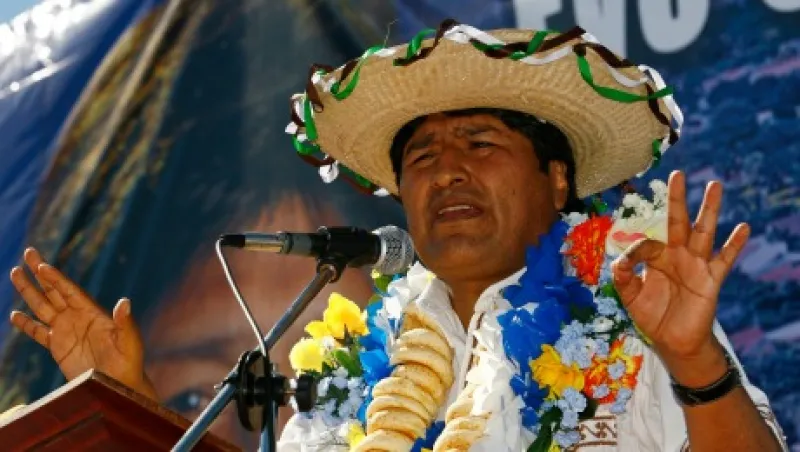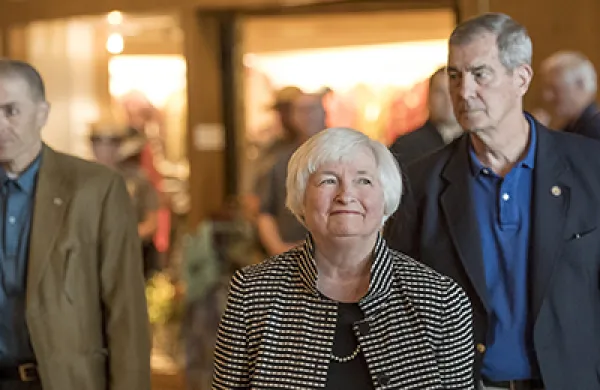As one of the biggest cities in one of the poorest countries in Latin America, Cochabamba, Bolivia, is full of contrasts. Its leafy northern districts are full of modern luxury apartment buildings, gourmet delicatessens, chic nightclubs and expensive four-wheel-drive vehicles. A short 15-minute drive away, however, gray 1970s-era buildings and squalid hotels mark the shabby old downtown area, where wizened Amerindian women dressed in traditional pleated skirts and black bowler hats beg for money.
During the past decade, this small, landlocked nation of 10.6 million people enjoyed one of the biggest booms in Latin America. Growth averaged 5 percent a year between 2006 and 2014, according to the International Monetary Fund, boosting per capita income to $2,900 from $1,190. Last year the economy expanded by 4.5 percent, far above the Latin American average of 0.3 percent, and the IMF forecasts it will grow by 3.5 percent this year. But the rising tide hasn’t lifted all boats, and now many are wondering whether the good times are coming to an end.
The steep drop in global commodities prices is taking its toll on the economy, even if Bolivia has so far fared much better than most of its neighbors. In 2015 the country ran its first budget deficit since 2005, and the trade balance dipped into the red for the first time in 11 years. Natural gas exports, one of the leading foreign exchange earners, dropped nearly 40 percent in value last year, and Brazil, which takes nearly a third of the country’s exports, continues to fall deeper into recession.
The slowdown helps explain the soft support for President Evo Morales as he seeks to win a constitutional referendum on Sunday that would allow him and his vice president, Alvaro García, to run for a third five-year term, possibly enabling the pair to stay in power until 2025.
A recent survey from Bolivian pollster Captura Consulting found 44.4 percent support for the change, whereas 41.1 percent oppose the measure. The narrow difference is striking for a president who enjoys a 69 percent approval rating and who won reelection in October 2014 with 61.4 percent of the vote.
Some Bolivians oppose the referendum measure because they are worried it will perpetuate a personality cult around Morales. It’s not hard to see why. The president is actually serving his third term currently, having first won election in 2005 when presidents were limited to a single term. But he pushed through a new constitution in 2009 that allowed for presidential reelection, and a court ruling reset the clock at zero for Morales under the new term limit provision.
Ironically, Morales counts global investors among some of his staunchest supporters today. A Socialist and member of the ethnic Aymara people, he became the country’s first president from the indigenous population by championing leftist policies as well as traditional Andean values of hard work, civility and social cohesion.
One of his first acts after taking office was to nationalize most of the country’s strategic industries, including the oil and gas company Yacimientos Petrolíferos Fiscales Bolivianos. He diverted the profits of YPFB and other nationalized companies to social welfare programs and infrastructure projects.Yet Morales has also demonstrated a remarkable degree of pragmatism and orthodoxy in other policy areas. The government has adopted a strict policy of inflation targeting with stark results: The inflation rate stood at just 2.95 percent in December, compared with 10.67 percent in Brazil, an estimated 30 percent in Argentina and a whopping 150 percent in Venezuela. The government has also welcomed foreign investors, and in the past two years has allowed them to explore for minerals in parts of this mountainous country that were previously off limits, incurring a backlash from some indigenous groups. That stance has enabled the country to more than double its natural gas production, from 10 billion cubic meters in 2004 to 20.8 billion in 2013, according to the U.S. Energy Information Administration.
“Morales’s hard-left government should be completely toxic to investors,” says Jan Dehn, head of research at Ashmore Group, a London-based emerging-markets investment firm. “However, in reality, we like Bolivia. Some investors draw simplistic conclusions. He might have left-wing alliances with Ecuador, Venezuela and Nicaragua, but, in practice, the country has followed fundamentally sound economic policies.”“Beneath all of the populist left-wing rhetoric, Bolivia has a sound and impressive economic record,” says Michael Shifter, president of Inter-American Dialogue, a Washington-based think tank specializing in Latin America. “It has been extremely well managed.”In Bolivia, as in much of the world, the benefits of growth haven’t been shared equally.
The poverty rate dropped from 57 percent in 2008 to 39 percent in 2013, but some people — private entrepreneurs and government officials who live in the northern district of Cochabamba, for example — have done much better than others. Keeping Bolivia on the expansion path is bound to get harder still for Morales, particularly if voters reject his referendum and shake investor confidence.The government adopted a countercyclical stimulus policy last year to shore up the economy, in part by drawing down its central bank reserves, which fell by $2 billion last year, to $13.0 billion at the end of December. The Morales administration has budgeted $8.2 billion for public investment this year, up from $7.2 billion last year (in the end, only 54 percent of that sum was disbursed). Investment was expected to amount to 22 percent of gross domestic product in 2015, but more than two thirds of that came from the public sector.
“During the last decade the public sector has been the main driver of economic activity,” says Erich Arispe, a Latin America analyst at Fitch Ratings in New York. “But now the country needs greater private sector involvement. The state does not have sufficient resources to explore for mineral deposits on its own, let alone extract them.”





